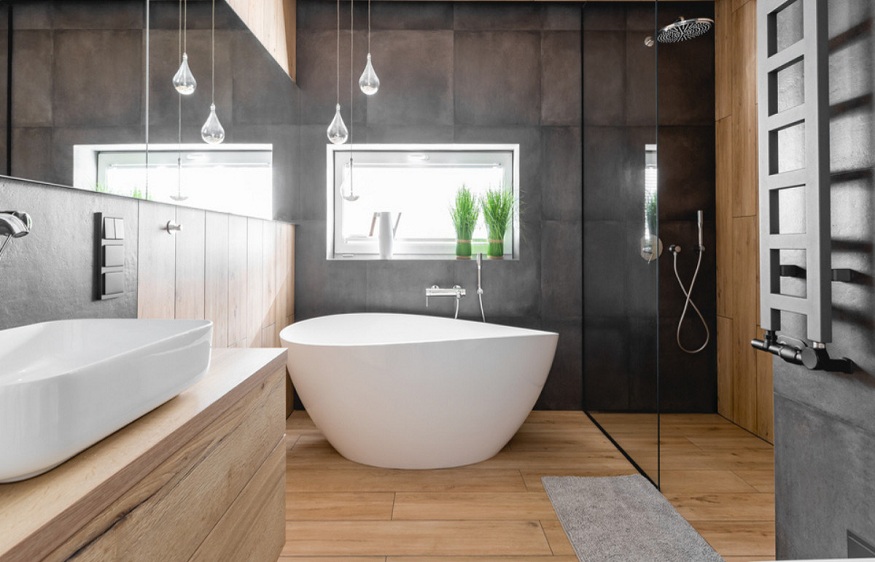More attention is often paid to materials when fitting out. In a bathroom, the materials covering the walls are important. Just like the floor, they must offer aesthetics, technical efficiency and ease of maintenance, so they must be at the heart of your bathroom renovation.
In addition to traditional tiling and painting, there are other solutions that are sure to give you satisfaction. We always advise to remain open to the idea of new aesthetics, because good surprises are commonplace. However, always remember to be consistent and strategic when choosing your bathroom wall covering.
MINERAL SOLUTIONS: TILING AND MOSAIC
Bathrooms have always been the temples of tiling, earthenware and mosaic. No mystery, for centuries these materials have been used in public baths and hammams, due to their technical properties. It is therefore logical to find them in our bathrooms, of course in more modern forms.
Wall tiles and earthenware
It is often said that bathroom wall tiles should be called earthenware, to differentiate them from floor tiles. It is actually an abuse of language, earthenware is a tile that has undergone bi-firing in order to reduce manufacturing times and therefore costs. Earthenware is however more fragile than tiles, and therefore often used in bathroom wall coverings.
Wall tiles are ideal in a bathroom as they will not allow water to enter the walls and provide a very easy to clean surface. It is also a material on which silicones and various sealants adhere particularly well and offer a perfect finish.
The case of the mosaic
The mosaic looks like small tiles (2cm x 2cm), and is made from glass paste. The mosaic has a particularly pleasing translucent aesthetic. However, it is much more expensive than tiling, and offers the same technical performance.
In all cases, care must be taken to use a water-resistant tile adhesive and a joint suitable for this environment. Generally modern seals and glues are all water resistant, but you will still need to monitor the evolution of their condition.
LIQUID COATINGS: PAINTS AND COATINGS
In association with tiling, we very often find paint and coatings as wall coverings for a bathroom. For example, tiles are very often laid in places directly exposed to water (around sinks or around bathtubs), and paint where water will very rarely be projected.
Painting: An easy and aesthetic solution
Glycero paint is expensive and has a very strong smell, but it is very effective at repelling water drops and does not allow mold to cling to its surface. In addition, this paint is very easily washable.
Water-based paint (acrylic) is less expensive, easier and quicker to apply. While it offers excellent performance, it does not reach the same level as Glycero paint.
Decorative plasters are increasingly used as bathroom wall coverings. These coatings have excellent technical cleanliness in addition to their luxurious aesthetics.
Bathroom coatings: A certain form of luxury
Generally, there are decorative bathroom coatings already prepared in 10, 15 or 20 kg pots. This mixture ideally dosed in the factory offers ease of installation and speed of implementation.
Tadelakt is the most luxurious of decorative coatings, this traditional Moroccan coating offers unfailing beauty and resistance to humidity close to that of tiles.
NATURAL WALL COVERINGS: WOOD AND STONE
In antiquity the Roman baths were covered with marble and/or similar stone. Stone has gradually disappeared from our bathrooms, but it is making a very strong comeback.
Indeed, stone, and in particular marble, are incredibly resistant to humidity. The smooth surface of the polished stone promises easy and quick cleaning, while offering a solidity that almost nothing will alter.
Stone: cold luxury
Marble in bathroom wall covering presents no difficulty, on the other hand in flooring, it will be necessary to add a non-slip solution.
It is also possible to equip the walls of your bathroom with wood.
A part of the low wall covered with paneling, protected by a layer of good quality Glycero paint offers an undeniable charm.
Tradition and voluptuousness with wood
To take advantage of the natural charm of wood, it will however be necessary to move towards species that are naturally resistant to humidity. We mainly use teak, ipe or wenge. The wood must be protected, in particular with an oil in which case it will be necessary to oil the wood regularly), or with a varnish resistant to humidity.
However, always take care to keep the wood in places where there is little or no water splashing. The edges of the washbasin and others will have to have a coating that is more resistant to water.
EASY WALL COVERINGS: WALLPAPER AND VINYL
The traditional wallpaper
Finally, wallpaper is making a comeback in our interiors, but also in our bathrooms. There are several types of wallpaper, some suitable for placing around a sink and some not.
Classic wallpapers (still washable) can be placed where water will never create splashes or drips. Their varied patterns make it possible to brighten up a bathroom at a lower cost with very simple work.
The special wallpaper
Where the humidity is higher, it will be necessary to move towards aspecial bathroom wallpaper. This wallpaper was developed especially for use as a bathroom wallcovering and is therefore to some extent resistant to moisture, even splashing.
If your bathroom is very humid and/or if your walls are in poor condition, vinyl wallpaper is ideal. This material takes the form of classic wallpaper, but has a layer of PVC on its surface.
This layer of PVC allows it to resist water and UV while being washable and brushable. In addition, the strength and thickness of PVC allow it to hide imperfections in the wall.

